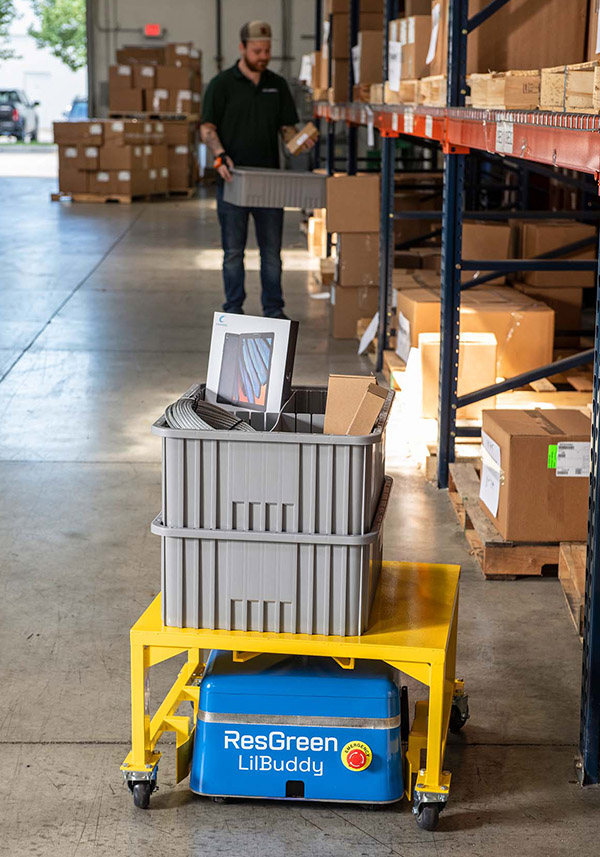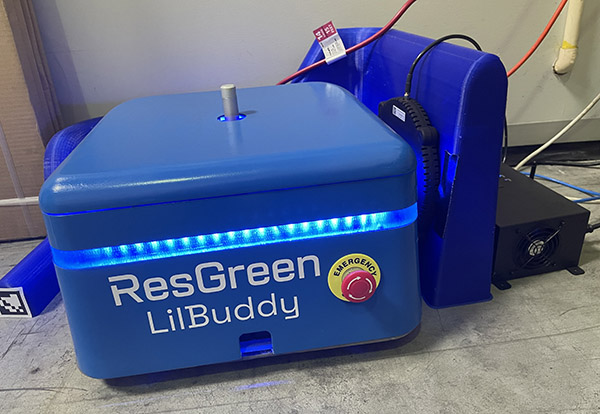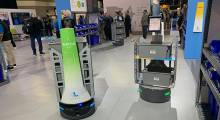WiBotic today announced that it has partnered with ResGreen Group International Inc. to enable ResGreen's LilBuddy autonomous mobile robots, or AMRs, to use wireless charging stations. This will allow the AMRs to operate for extended periods without human intervention, said the companies.
“We are thrilled to partner with WiBotic to provide wireless charging on our vehicles,” said Parsh Patel, CEO of ResGreen. “WiBotic’s technical support and dedication has helped us create the best option for our customers. Wireless charging is transforming the material handling industry by providing increased flexibility in mobile robot systems.”
Shelby Township, Mich.-based ResGreen provides software, automated guided vehicles (AGVs), AMRs, and industrial automation. The company said its engineers use the Internet of Things (IoT), the MQTT protocol, and the Robot Operating System (ROS) to design interoperable technologies.
ResGreen designs LilBuddy for tight spaces

LilBuddy has a 17 in. by 17 in. base and can rotate 360 degrees in narrow aisles, making it suitable for supermarkets, offices, restaurants, and more, said ResGreen.
The AMR is available in a hybrid model that uses both natural feature and magnetic tape guidance, said ResGreen.
“For pinpoint stopping accuracy, it uses magnetic tape, which allows it to stop in close proximity to the wireless charger,” said Sarah Carlson, vice president of marketing communications at ResGreen. “Very dirty or dusty environments can provide challenges, which can typically be solved by cleaning the chargers.”
“LilBuddy AMRs are remarkable, streamlined robots. Despite their compact size, they’re capable of moving loads in excess of 220 lb.,” stated Ben Waters, CEO of WiBotic. “They are perfect for navigating smaller spaces and – when integrated with our wireless charging capabilities – offer a compelling, low-maintenance solution for organizations looking to introduce autonomous mobile robots into their operations.”
“We're excited about this collaboration and that ResGreen can use wireless power for LilBuddy,” he told Robotics 24/7. “Its value proposition resonates with wireless charging.”
WiBotic adds resilience to recharging
Seattle-based WiBotic specializes in advanced charging and power optimization for aerial drones, mobile robots, and industrial automation. The company said its wireless charging capabilities allow the AMRs to charge efficiently and frequently without wearing out contacts or requiring precise navigation to charging stations.
What are some of the environmental challenges for wireless charging?
“One of the biggest challenges is the tolerance,” Waters replied. “A company might want accuracy to 1 cm, based on the robot's lidar and camera, but then if you add tolerance of the wheels and steps to pivot, the robot can dock within 3 to 5 cm. We try to maximize positional flexibilty.”
“If it’s outside of that range, an AMR will still charge, but not at the full rated current,” he added. “The API will tell if it's 3 amps instead of 10 amps, and the robot can then decide.”
“We have a lot of customers that build outdoor robots, and in warehouses, dust a serious challenge,” said Waters. “Sometimes, customers have robots at an IP54 rating for water resistance or IP53 for limited dust ingress. That's where most robots are heading, and some have to be more waterproof at IP66 or IP67.”
WiBotic has different form factors and costs for its standard products, with some custom designs and receptiveness to feedback, he said.
Charging, data infrastructure needed for fleets to scale
“As companies deploy mobile robots at scale, they must solve problems of costs, uptime, and maintenance,” Waters noted. “They want a common infrastructure, including charging.”
One wireless station can also charge a variety of vehicles with different battery types, sizes, and configurations requiring different voltages and charging rates, according to WiBotic. In addition, the company said its technology provides opportunities for data management.
“If Wi-Fi drops out or a robot gets stuck, the AMR can go back to a charging station and offload data,” explained Waters. “This allows for diagnostics and recovery for the communications network—separate from charging—as part of WiBotic Commander, which does fleet energy management.”
ResGreen’s BotWay software for real-time monitoring and control of AMRs will soon include WiBotic Commander functionality for better visibility into fleet-wide charging station use and energy consumption, said the companies.
WiBotic works closely with customers
WiBotic and ResGreen have collaborated since the middle of last year, said Waters. WiBotic always works with its customers to determine the best combination of wired or wireless chargers, docking stations, and software for their products, he claimed.

“With any customer, there are three things that happen,” Waters said. “First is the purely mechanical integration, as we figure out where to put the onboard charger. It's impacted by height—while the WiBotic system is quite small and uses standard mouting ads, it's impacted by height, and you don't want to block a camera.”
“Second is the electrical integration,” he said. “We've seen the complete spectrum of some robots that have dedicated power-distribution systems and ports to plug in, and others with nothing or batteries connected with wires.”
“Third, we work on the software for docking,” Waters said. “Some companies just look at the battery current, but that doesn't say how long a robot has to wait or if it's fully charging. WiBotic has an API that knows right away if AMRs are in range for power transfer. We have documentation and support for ROS. A lot of things we're doing in the software is solving that last 10%, making it more plug and play.”
Building on the MassRobotics interoperability standard
In addition to its own power and fleet management software, WiBotic has participated in MassRobotics' interoperability standards efforts, which seek to enable robots from different vendors to communicate in shared environments.
“Instead of one onboard charger talking to the robot it's installed on, we built Commander because of that requirement for communications at the fleet level,” Waters said. “It's hard for customers to consolidate data from multiple robots, especially in an interoperable fleet.”
“WiBotic Commander is an API and user intereface to communicate and visualize a whole fleet of charging stations and onboard chargers,” he added. “What we want it to be is a tab in someone's fleet management ecosystem, providing all the energy and power data they want to see.”
“Over time, we can apply some analytical tracking and build reports on which robots and charging stations are underutilized, for example,” said Waters. “Most robot companies don't have data from both the dock and the robot. We're working with fleet management software providers.”
MassRobotics has been working to develop vendor-agnostic standards for robots to share positional information, their identification, and charging status. WiBotic will then add that layer to its own code and comply with that structure, Waters said.
“We hope to continue to be involved there,” he said.
More charging, data to come
ResGreen said it plans to add WiBotic’s wireless charging capabilities to its larger PullBuddy AGVs in the near future. The main challenge for larger robots is that they require larger batteries, so they would need a different onboard charger at the same voltage but different current, noted Waters.
“A robot might have a huge battery, but it won't necessarily charge quicker,” he said. “It depends on the battery.”
“We're working to add the WiBotic onboard charger to other robots to maximize fleet uptime and save money,” added Waters. “Why utilize 100 robots if you need only 80?”
While WiBotic has faced supply chain challenges, its business has grown, and Waters said he expects the company to add more communications and data management capabilities this year.
About the Author
Follow Robotics 24/7 on Linkedin
Article topics
Email Sign Up

















